Miami Marlins All-Time Top 50 Players

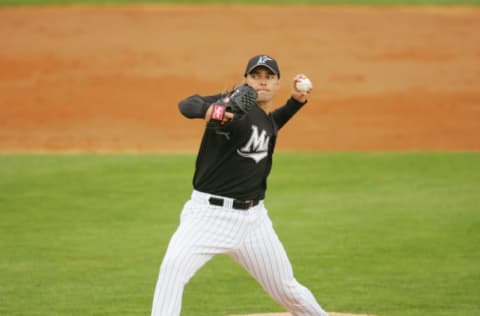
Over their first 27 seasons, the Florida / Miami Marlins have seen 590 get into a big league baseball game and face at least one pitcher or batter.
Now, this isn’t the New York Yankees, the Chicago Cubs, or the Boston Red Sox, with over 100 years of history to draw upon. This isn’t even the New York Mets or Houston Astros, with over 50. The Miami Marlins, and their sister team, the Colorado Rockies, are the 27th and 28th oldest existing major league ball clubs. As such, their low man, at 50th, is lower than most other teams. Likewise, their #1 is also lower than most teams.
I’ll be using baseball-reference.com and their brWAR metric to measure these players against one another. I think it’s the best statistic available to ascertain who is more valuable to a club, pitcher against hitter, starter against reliever, or 1993 against 2019 (or later).
This slideshow is too large to just shoot out into the atmosphere, so I’ll be breaking it up into five. Today, players ranked 50 through 41 will be represented.
Who Came Up Just Short?
60. Sandy Alcantara (3.3)
Sandy Alcantara nearly forced his way onto this list with a hard push at the end of the 2019 season. It’s perhaps emblematic of the dearth of Miami Marlins history that a 3.3 WAR is the 60th best in franchise history. Nothing against Alcantara though. He’s sure to work his way onto the top 50 in no time flat.
59. Mark Buehrle (3.5)
Mark Buehrle was a longtime starter for the Chicago White Sox before joining the Marlins for a single season in 2012. He went 13-13 in 31 starts, with 125 K’s in 202 innings. He had a 4.18 FIP, a 3.74 ERA, and a career second-best WHIP of 1.171.
58. Emilio Bonifacio (3.5)
Emilio Bonifacio spent four seasons with the Marlins, joining the team in 2009 and staying with them until they were the Miami Marlins in 2012. In 416 games, he slashed .271/.332/.345. Although he spent major league time on seven other teams through his career, over half of his time was with the Marlins.
57. Moises Alou (3.5)
Moises Alou only spent one season with the Marlins, and helped them to their first World Series Championship, in 1997. In 150 games, he slashed .292/.373/.493, with 23 home runs and 115 RBI.
56. Braden Looper (3.6)
Braden Looper played for the Florida Marlins from 1999 through 2003. In 368 appearances, he was 19-16 with 46 saves and 242 strikeouts in 388 innings.
More from Marlins News
- Miami Marlins can’t afford to botch this trade
- Miami Marlins news: the New York Mets are a risky threat
- Miami Marlins keep missing out on stars
- Miami Marlins rumors: New closer?
- Miami Marlins attempted to sign 2 bats
55. Alfredo Amezaga (3.7)
Alfredo Amezaga, who made more starts at center field than anywhere else, also appeared everywhere else on the diamond excepting the battery. In 437 games fro the Marlins, he slashed .255/.315/.339.
54. Quilvio Veras (3.9)
Quilvio Veras led the major leagues in 1995 with 56 stolen bases, and slashed .258/.383/.361 in his two seasons with the Florida Marlins. He later played three seasons with the San Diego Padres and another two with the Atlanta Braves.
53. Bryan Harvey (4.0)
Bryan Harvey was the first bonifide closer for the Florida Marlins in 1993. Over parts of three seasons, he saved 51 games in 59 appearances, striking out 83 in 79 innings, going 1-5 with a 2.50 ERA, and finishing with a dominant 0.971 WHIP.
52. Starlin Castro (4.0)
If Starlin Castro hadn’t started off the 2019 campaign so dreadfully, he’d probably be around the number 40 player on the list. As it stands, his time with the Miami Marlins has come to a close, and he’ll never move up this list.
51. Chris Volstad (4.2)
Chris Volstad was 32-39 in four seasons as part of the Florida Marlins rotation, with a 4.59 ERA over 103 starts. After starting 21 games in 2012 for the Chicago Cubs, he later appeared in relief for the Colorado Rockies, the Pittsburgh Pirates, and the Chicago White Sox.
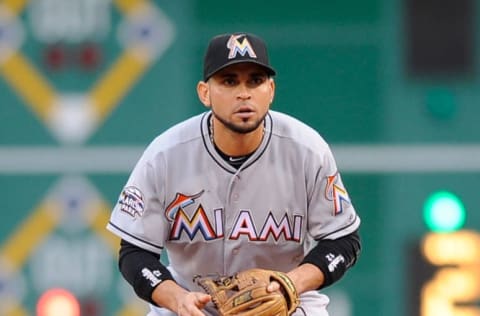
50. Omar Infante (4.3)
Omar Infante was a 5’11”, 195 lb. infielder from Puerto La Cruz, Venezuela. Born on the day after Christmas in 1981, he signed with the Detroit Tigers through international free agency in 1999.
Infante made his way up through the Tigers system for the next few seasons, making his major league debut with Detroit in 2002. Over the next six seasons, he slashed .253/.298/.386 with 32 homers and 34 stolen bases in 494 contests. He then played three years with the Atlanta Braves, slashing .309/.353/.411 in 300 games and making the National League All Star team in 2010.
After the 2010 season, the Braves traded Infante to the Miami Marlins with Mike Dunn for Dan Uggla. Infante’s first season with the Marlins was the last season they were called the “Florida” Marlins, and Infante’s third-best season as a major leaguer, going by his brWAR of 2.4. In a then-career-high 148 games, he slashed .276/315/.382, with seven round-trippers and 49 RBI.
Infante played in 85 Miami Marlins games in 2012, and slashed .287/.312/.442 with eight home runs, 10 stolen bases, and 33 RBI. As the trade deadline was getting closer, and the Marlins decided they were sellers, Infante was traded with Anibal Sanchez back to the Tigers for Rob Brantly, Brian Flynn, and Jacob Turner.
Infante played another year and a half for Detroit, then three seasons with the Kansas City Royals. He last appeared in the major leagues in 2016.
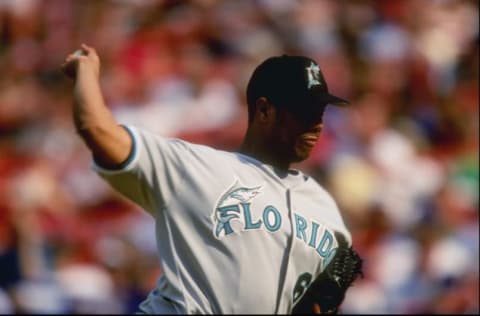
49. Livan Hernandez (4.5)
Livan Hernandez had a long and notable major league career, playing for a total of nine teams over 17 seasons. Going by ERA+, his second-best season was with the Florida Marlins during their 1997 World Series Championship run.
A Cuban defector, Hernandez signed with the Florida Marlins In January 1996. After spending most of that first calendar year between the Marlins double- and triple-A affiliates (the Portland Sea Dogs and the Charlotte Knights, respectively), Livan joined the Marlins rotation in mid-June of 1997.
Hernandez made 17 starts for the Marlins during the regular season that year, including a gem against the Cincinnati Reds on July 30th. He earned his fifth win (against zero losses) by holding the Reds scoreless on three hits and a pair of walks over eight innings, striking out eight. He ended up 9-3 with a 3.18 ERA and a 1.235 WHIP over 96 1/3 innings.
In the Marlins title run, Hernandez won both the NLCS and the World Series Most Valuable Player award. In 29 1/3 postseason innings, Hernandez struck out 26 and went 4-0 with a 3.07 ERA.
Hernandez remained with the Marlins until halfway through the 1999 campaign, when he was traded to the San Francisco Giants for Nate Bump and Jason Grilli. In total, he was 24-24 for the Marlins, with a 4.39 ERA and a 1.510 career WHIP.

48. Devon White (4.5)
Devon White was a sixth round pick of the California Angels in the 1981 amateur draft. A Kingston, Jamaica native, White was a switch-hitting, right-handed throwing centerfielder.
Four years after getting drafted, White made his way to the Angels, and ended up roaming center field for them for the next six seasons. He won American League Gold Gloves in 1988 and 1989, also making his first all star game in 1989. He slashed .247/.295/.389 in 612 games, with 59 homers, 241 RBI, and also swiped 123 bases.
After the 1990 campaign, White was traded with Willie Fraser, and Marcus Moore to the Toronto Blue Jays with Junior Felix, Luis Solo, and PTBNL Ken Rivers.
With the Blue Jays, White won AL Gold Gloves in each of his five seasons, returning to the all star game in 1993. He appeared in 656 games in total, with 72 homers, 274 RBI, and 126 stolen bases.
Following the 1995 season, the Florida Marlins signed the then-33-year-old White to a three-year, $9.9 million contract. White played in 146 games his first season in the National League, and batted .274/.325/.455 in 146 games for the Marlins. He totaled 17 homers with 22 stolen bases and 84 RBI.
In 1997, White appeared in 74 regular season games for the Marlins due to injury. He slashed .245/.338/.370 with six homers, 13 stolen bases, and 34 RBI. In 16 postseason games, he went 14-for-65 with seven RBI, helping the Marlins to their first World Series title. After winning it, the Marlins traded White to the Arizona Diamondbacks for Jesus Martinez.
White spent one season with the Diamondbacks, making his first NL all-star team. He later played two years with the Los Angeles Dodgers and one for the Milwaukee Brewers.
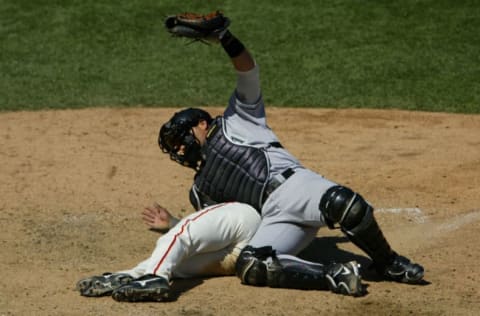
47. Ivan Rodriguez (4.5)
Ivan Rodriguez is a 5’9″, 205 lb. Hall of Fame catcher from Manati, Puerto Rico. He made his major league debut in 1991 for the Texas Rangers, and finished fourth in the American League Rookie of the Year vote.
Rodriguez spent a total of a dozen seasons with the Rangers in his first turn with them, making 10 all star teams, winning 10 Gold Gloves, six Silver Sluggers, and the 1999 AL Most Valuable Player award.
Rodriguez tested free agency for the first time prior to the 2003 season, and signed a one-year, $10 million deal to play for the Marlins. Although he spent only one season with the Fish, Rodriguez earned enough Wins Above Replacement to place 47th on this list, with 4.5.
Rodriguez slashed .297/.369/.474 for the Marlins in 144 contests. He hit 16 home runs with 85 RBI and 10 stolen bases. He also threw out 20-of-60 would-be base stealers during his time behind the plate.
In helping the Marlins to their second World Series title, Rodriguez went 21-for-67 at the plate, with five doubles, three homers, and 17 RBI in 16 games. He was best in the seven-game series win over the Chicago Cubs, during which he collected five singles, two doubles, two homers, and 10 RBI.
After the season, Rodriguez left the Marlins through free agency to sign with the Detroit Tigers. He played four and a half seasons there, followed by half of a year with the New York Yankees, a year split between the Houston Astros and the Rangers, and two seasons with the Washington Nationals.
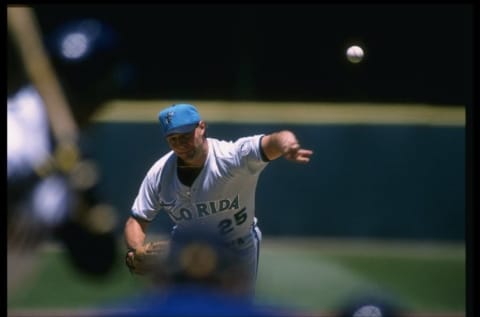
46. Al Leiter (4.8)
Al Leiter was a 6’2″, 200 lb. left-handed pitcher from Toms River, NJ. Born on October 23rd, 1965, he was a New York Yankees second round pick in 1984. He made his major league debut with the storied club in 1987, and pitched in a total of 22 games for them prior to getting moved to the Toronto Blue Jays system for Jesse Barfield.
Although Leiter spent his rookie status in 1988 with the Yankees, he only pitched 15 2/3 innings at the major league level in his first four seasons with Toronto. He finally arrived for keeps in 1993, when he was 9-6 for the the Jays. He eventually pitched in 91 games for Toronto, starting 61 of them and going 26-24 with a 4.20 ERA. After the 1995 season, Leiter decided to test the free agency market.
The Florida Marlins inked Leiter to a free agent contract, and watched him go 16-12 with a 2.93 ERA in his first season in South Florida. He didn’t miss a turn in the rotation, making 33 starts, and he also made the all-star team for the first time in his career, finishing ninth in the National League Cy Young Award vote. Leiter posted a 1.263 WHIP and struck out 200 in 215 1/3 innings.
Leiter did not make the all star team during the Marlins championship run the following season, but instead went 11-9 with a 4.34 ERA over 27 starts. He earned a ring despite a WHIP of just below two.
Prior to Spring Training the following year, Leiter was traded with Ralph Milliard to the New York Mets for Rob Stratton, A.J. Burnett, and Jesus Sanchez (not that one).
Leiter remained with the Mets for seven seasons before again signing as a free agent with the Florida Marlins. After going 3-7 with a 6.64 ERA over 16 starts, Leiter was traded back to the Yankees to close out his career.
When it was all said and done, Leiter had completed a 19-season major league career and had won 162 contests. He has since enjoyed a successful second-career as a television commentator.
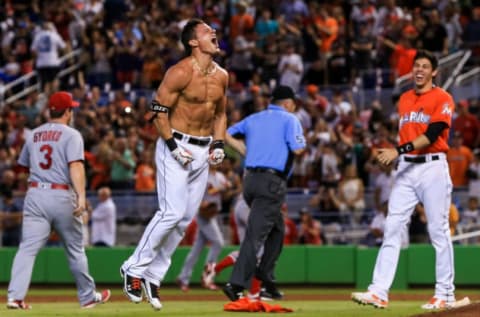
45. Derek Dietrich (4.8)
Initially drafted by the Houston Astros in the third round of the 2007 draft, Derek Dietrich instead played three seasons with Georgia Tech. After slashing .331/.432/.586 in 182 NCAA Division I contests, the Tampa Bay Rays chose him in the second round in 2010.
Dietrich made his way up through the Rays system over the next three seasons, with stops for the Hudson Valley Renegades, the Bowling Green Hot Rods, the Charlotte Stone Crabs, and the Montgomery Biscuits. After the 2012 season, the Rays traded him to the Miami Marlins for Yunel Escobar.
In 2013 and 2014, Dietrich still wasn’t really a full-time major leaguer, splitting his time between the Marlins, the Jacksonville Suns, the New Orleans Zephyrs, and the Jupiter Hammerheads. For Miami, he appeared in 106 games over that time, slashing .220/.297/.397 with 14 homers and 40 RBI. He also had 17 HBP during that time, showing early promise at a niche talent.
In 2015, Dietrich spent 56 games with the Zephyrs and 90 contests with the Marlins. He slashed an improved .256/.346/.456 with 10 homers and 24 RBI, and his .802 OPS ranked higher than any Marlins player who actually qualified for the leaderboard in that aspect. (Giancarlo Stanton had a .952, but only appeared in 74 games).
In one very specific area, Dietrich may actually be considered a generational talent. 2016 would see him lead the NL with 24 HBP, while slashing a career best .279/.374/.425 in 128 games. The following season would see more of the same with a slight regression in his slashline, at .249/.334/.424. He also hit 13 homers with a career best 53 RBI.
In 2018, Dietrich slashed .276/.340/.441 with a then-career best 16 homers and 45 RBI. He also struck out 140 times, which translates to over a quarter of the time. That’s the first time he has whiffed at such a prolific rate. For all the grief that I’ve heard Dietrich receive for his unnatural left-fielding last year, his .993 fielding percentage ranked fifth in the NL. That spoke directly to Dietrich’s persistence in trying to round his skillset as a ballplayer.
After the close of the season, Dietrich was granted free agency, and quickly found a home with the Cincinnati Reds. After quickly flirting with the National League home run leaderboard, Dietrich cooled off and is ended up hitting just .187/.328/.462, with 19 round-trippers and 43 RBI. He also set a new career-high with 25 HBP despite appearing in only 113 games.
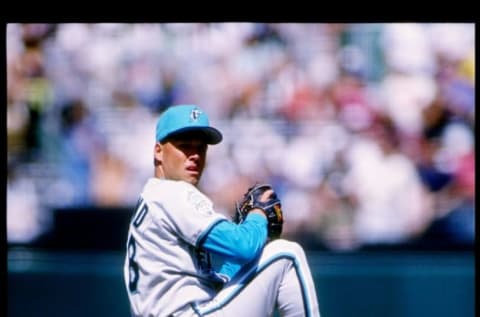
44. Chris Hammond (4.9)
Chris Hammond was a 6’1″ left-handed starter from Atlanta, Georgia. In 1986, the Cincinnati Reds chose him in the sixth round of the amateur entry draft.
It took Hammond four seasons, but in 1990 he made his major league debut on a pitching staff with “Nasty Boys” Rob Dibble, Randy Myers, and Norm Charlton. He played three seasons with the club, going 14-19 with a 4.25 ERA and 133 K’s in 258 1/3 innings.
Just before the Florida Marlins began their inaugural season in 1993, the Reds sent Hammond to the Marlins for a PTBNL (Hector Carrasco). Hammond immediately joined the Marlins rotation as their number three starter. He made 32 starts, and led Florida with 11 wins, going 11-12 with a 4.66 ERA. He struck out 108 over 191 frames, and allowed 1.429 WHIP. He was also named the NL Pitcher of the Month in June, during which he won all six of his starts.
Following that first season, Hammond played the next three with the Marlins. In 13 starts in 1994, he posted a much-better 3.07 ERA while going 4-4 with a 1.391 WHIP. In 1995, he struck out 126 in 161 frames for a career-best 7.0 K/9. In 1996, he made his first tentative move to the bullpen, starting nine times and appearing in relief in 29 contests.
Granted free agency following the 1996 season, Hammond signed with the Boston Red Sox for 1997. After going 3-4 with a 5.92 ERA, he was released, signed by the Kansas City Royals, and again released prior to 1998 Spring Training. The Marlins said, “Why Not?”
They soon found out. Hammond started three times for Florida in May, and went 0-2 while giving up 20 hits and eight walks over 13 2/3 innings for a 2.049 WHIP. With his wife in the midst of a difficult pregnancy, Hammond decided to retire to spend time with his family.
But four years later, Hammond wanted to see if he had anything left in the tank. He did.
Hammond’s 2002 season was his best as a professional, and one of only three sub-1 ERA seasons’ in history. He went 7-2 for the Atlanta Braves as a reliever, with a 0.95 ERA and 63 K’s in 76 innings. He played another four seasons after that, with the New York Yankees, the Oakland Athletics, the San Diego Padres, and the Reds.
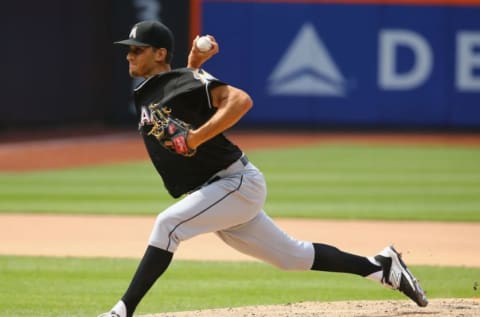
43. Steve Cishek (4.9)
Steve Cishek is a 6’6″, 215 lb. right-handed pitcher from Falmouth, Massachusetts. Born on June 18th, 1986, he was the fifth round pick of the Florida Marlins in 2007. He made his Marlins debut in 2010, striking out three and allowing one walk in 4 1/3 innings across three appearances.
Cishek struck out 55 in 54 2/3 innings for the Marlins in 2011, going 2-1 with three saves and a 2.63 ERA. He held opponents to a 1.171 WHIP and an opposing slashline of .221/.296/.294, with 19 walks.
In 2012, Cishek went 5-2 for the newly rechristened Miami Marlins, with 15 saves, a 2.69 ERA, 68 K’s in 63 2/3 innings, a 152 ERA+, and a 1.304 WHIP. He started out the season as a setup man, but soon afterward inherited the closer role due to the complete ineptitude of Heath Bell. Cishek would hold on to the role for the rest of his time with the Marlins.
2013 would see submarine-style Cishek make 34 saves and go 4-6 in 69 appearances in total. He earned a 2.33 ERA, struck out 74 in 69 2/3 innings, put up a 167 ERA+, and kept batters to a 1.077 WHIP.
In 2014, Cishek saved a career-high 39 games for the Miami Marlins. He went 4-5 with a 3.17 ERA, 84 K’s in 65 1/3 innings pitched, and a 1.209 WHIP. He lost the closer role near the start of the 2015 season to A.J. Ramos after initial struggles, including a career-worst 85 ERA+. The Marlins traded him to the St. Louis Cardinals straight up for Kyle Barraclough.
Cishek has since pitched with the Cardinals (0-0, 2.31), the Seattle Mariners (5-7, 2.89), the Tampa Bay Rays (2-1, 1.09), and the Chicago Cubs (8-9, 2.55).
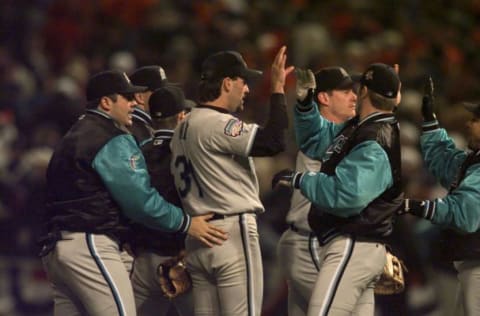
42. Robb Nen (4.9)
Robb Nen was a 6’4″, 200 lb. right-handed pitcher from San Pedro, CA. Born on November 28th, 1969, Nen was a 32nd round selection of the Texas Rangers in 1987.
Nen took six years in the Rangers system, but finally made his way up to the majors during the 1993 campaign. In 22 2/3 innings for Texas, he had a 2.382 WHIP, including 26 walks and only 12 strikeouts. On July 17th of that year, the Rangers traded Nen with Kurt Miller to the Florida Marlins for Cris Carpenter.
After joining the Marlins, Nen’s numbers dramatically improved. He walked 20 over 33 1/3 innings and struck out 27, with a WHIP of 1.650. Overall that season, he posted a 6.75 ERA, with a 5.45 FIP which suggested that maybe he wasn’t really as bad as all that.
In 1994, Nen started the season in the Marlins bullpen, later inheriting the closer role after Bryan Harvey (six saves). He totaled 15 saves for the Fish, going 5-5 with a 2.95 ERA, 60 K’s in 58 innings, a 1.086 WHIP, and an opposing slashline of .222/.280/.382. Nen’s 44 total appearances ranked second on the team, behind Richie Lewis‘ 45. He also ranked as Florida’s most valuable per-inning pitcher, with a team-best 148 ERA+.
1995 would see Nen get into a team second 62 games, leading the club with a 128 ERA+ and 23 saves. In 65 2/3 innings, he struck out 68 and racked up a 3.29 ERA. He had a 1.294 WHIP and a 3.32 FIP while going 0-7 in decisions.
1996 was Nen’s best season with the Florida Marlins. In an NL-sixth 75 contests, he saved an NL-sixth 35 games, going 5-1 with a 1.95 ERA. With a 2.06 FIP, it seemed to be sustainable (it was, but ultimately not for Florida). Nen struck out 92 in 83 innings with a 1.060 WHIP while holding batters to a .225/.277/.299 slashline, and his 3.7 positive WPA ranked ninth in the NL.
In 1997, Nen again converted 35 saves for the Marlins, with 81 whiffs in 74 innings through the regular season. Clearly his worst season for the Marlins, he posted a 1.514 WHIP and a 3.89 ERA, going 9-3. Not bad, for a bad season. Later, in the postseason, Nen appeared in eight games, saving four and striking out nine in 8 2/3 innings for the eventual World Series Champions.
After the season, the Marlins traded Nen to the San Francisco Giants for Mick Pageler, Mike Villano, and Joe Fontenot. Nen went on to earn three all-star invitations over his five seasons with the Giants, going 24-25 with 206 saves, a 2.43 ERA, and a 1.084 WHIP.

41. Edgar Renteria (5.0)
Edgar Renteria was a 6’1″, 180 lb. shortstop out of Barranquilla, Columbia. Born on August 7th, 1976, he was signed through international free agency in 1992 at just 15 years of age.
Renteria worked his way up through the Florida Marlins system with a stop at each level for one season, from the GCL Marlins to the Kane County Cougars to the Brevard County Manatees to the Portland Sea Dogs and the Charlotte Knights in 1996. Also in 1996, he earned his first look at the major league level with the Marlins. In 106 games as a 19-year-old, he hit .309/.358/.399 with five homers, 31 RBI, and 16 stolen bases. For his efforts, he finished second in the NL Rookie of the Year vote, beat out by a guy named Todd Hollandsworth. Renteria ranked ninth in the NL with a 1.6 dWAR, fourth with an 88.9 percent steal rate, and second with a 4.95 RF/9 as a shortstop. All this as the second youngest player in the National League.
In 1997, Renteria slashed .277/.327/.340 in 154 games for the eventual World Series Champion Florida Marlins. He stole an NL-ninth 32 bases and led the NL with 19 sacrifice hits. He was seventh in the NL with 617 at bats, sixth with 691 plate appearances, second with 143 singles, and led the senior circuit with 242 putouts at shortstop. In the postseason, Renteria was 16-for-66 with three doubles, four RBI, and one stolen base. Not exactly great, but he did give us this moment:
In 1998, Renteria was invited to his first all star game, out of a total of five he would play in through his 16 season major league career. He hit .282/.347/.342 in 133 games for the Marlins. His 41 stolen bases ranked him fourth in the NL. For the week of June 14th, he earned his first of three eventual NL Player of the Week awards by going 13-for-28 with four walks, seven runs, a double, three RBI, and two stolen bases.
The Marlins traded Renteria to the St. Louis Cardinals after the 1998 season for Armando Almanza, Braden Looper, and Pablo Ozuna. Renteria would play six season with the Cardinals, followed by a season with the Boston Red Sox, two years with the Atlanta Braves, a season with the Detroit Tigers, two years with the San Francisco Giants, and a season with the Cincinnati Reds.
Next. Marlins All-Time Top 50: Part 2 (40-31). dark